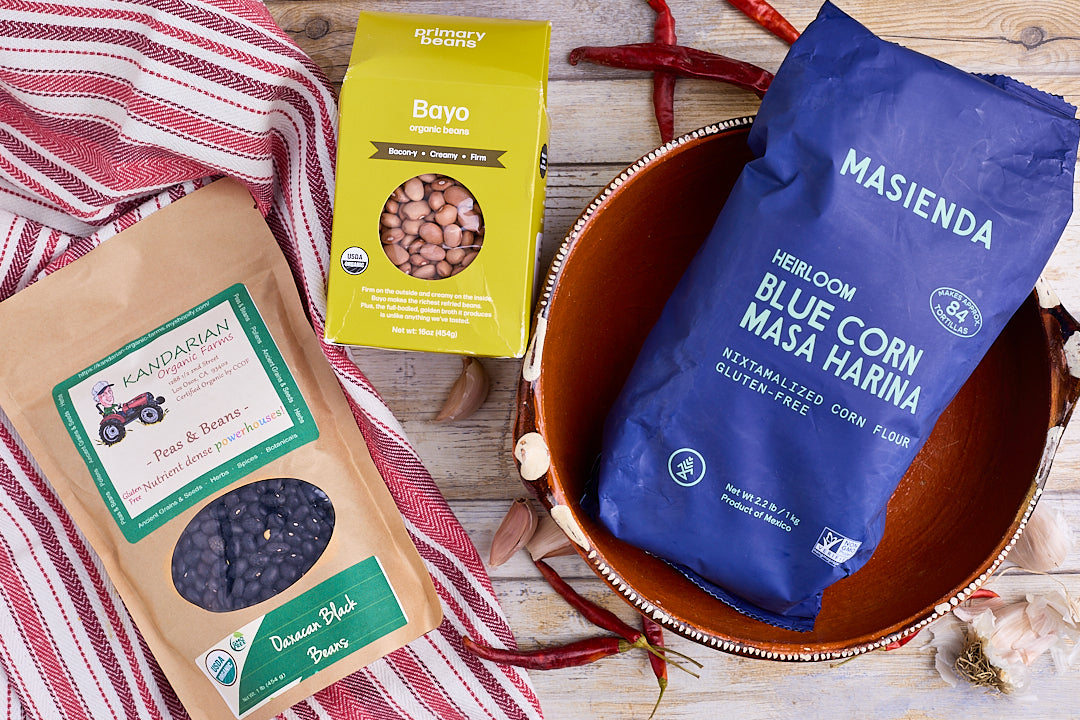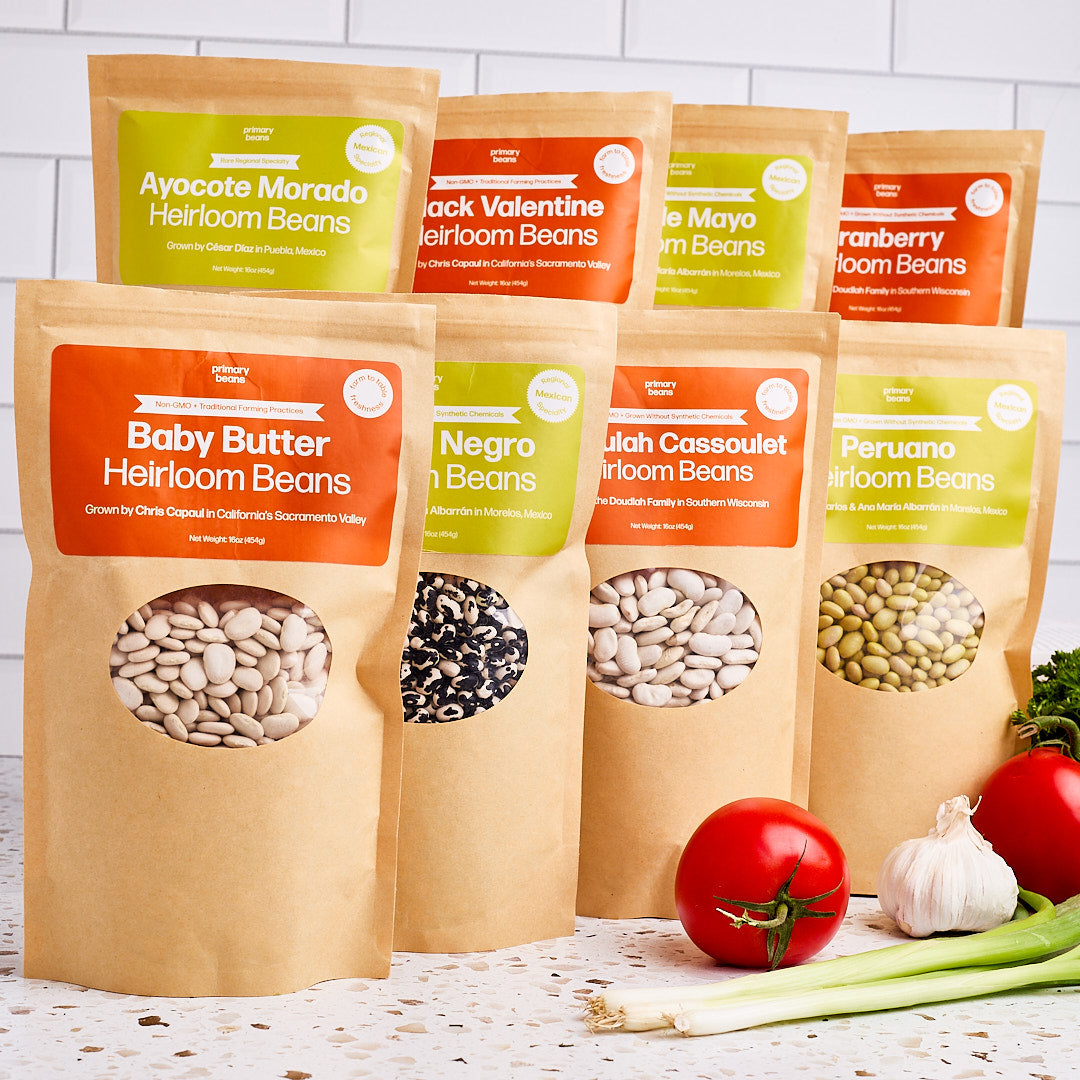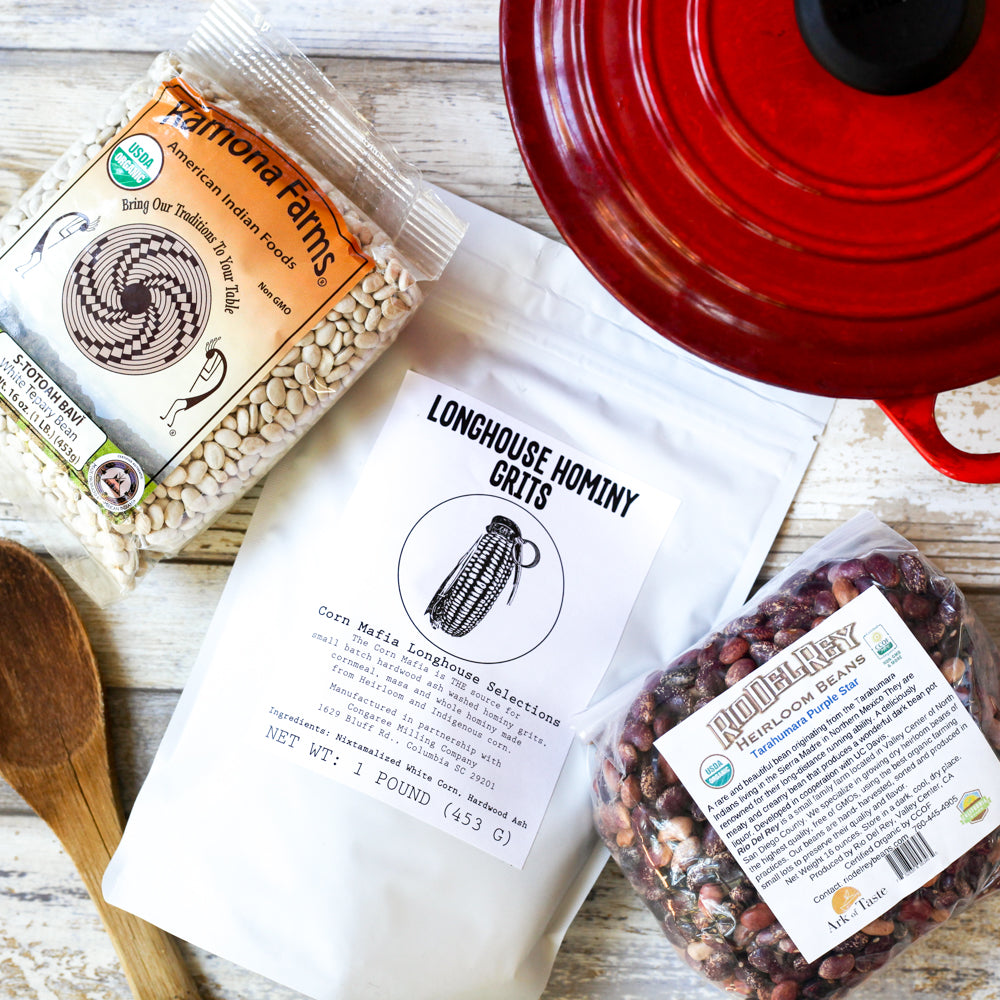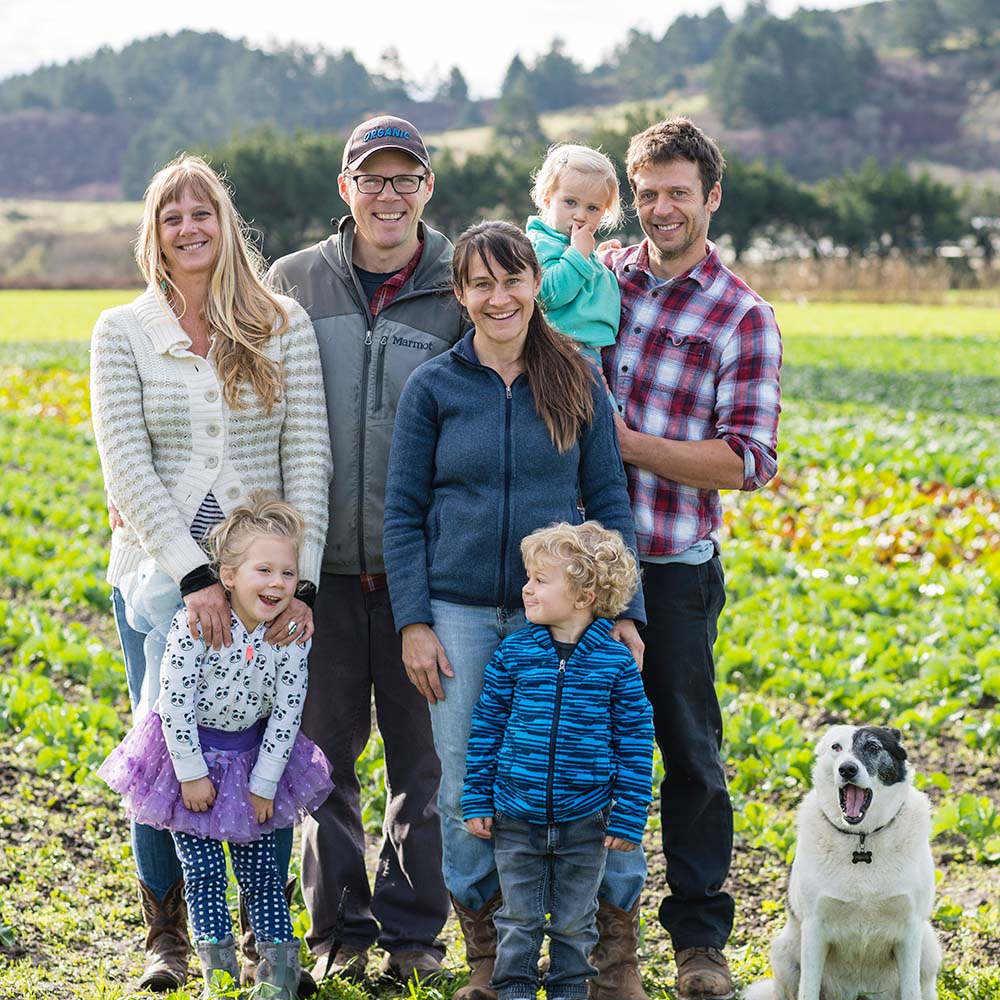Flat Rate Shipping $10.99
Flat Rate Shipping $10.99
SHOP

April 2024 Heirloom Bean + Grain Club
April 04, 2024 7 min read
Hello fellow food explorers! Get ready to take your taste buds on a journey south of the border with the April edition of the Heirloom Bean and Grain Club. This month, we're diving into the rich food traditions of Mexico, where every bite tells a story and the birthplace of most of the world's first beans. First up, we've got Organic Bayo beans, the heart and soul of Central Mexican cuisine, ready to infuse your dishes with authentic flavor. Then, we're off to Oaxaca, hailed as the black bean capital of the world, where you'll discover the true essence of Mexican gastronomy. And let's not forget a jaunt to Northern Mexico, specifically the state of Tarahumara, where heirloom blue corn masa awaits, promising to add a touch of tradition to your tortillas and tamales. So grab your apron, pour yourself a margarita and join me as we embark on a culinary journey through the vibrant flavors of Mexico!
THE BEAN AND GRAIN BOX CONTAINS:
Organic Bayo Beans, Organic Oaxacan Black Beans, Heirloom Blue Corn Masa Harina
THE BEAN ONLY CONTAINS:
Organic Bayo Beans, Organic Oaxacan Black Beans,
NEW TO THE CLUB?
Check out our blogposts with everything you need to know to get the most out of your membership in the heirloom bean and grain club.
How To Cook A Perfect Pot of Beans
The Definitive Guide To Cooking Beans
ORGANIC BAYO BEANS
Step into the rich culinary world of central Mexico with Bayo Beans, a cherished heirloom variety that holds a special place in the heart of Mexican cuisine. These beans, often mistaken for their cousin, the Mayacoba, are in fact a distinct heirloom varieity. While Pinto beans reign in the north and black beans in the south, it's the Bayo bean that captures the essence of central Mexican cooking. Revered by locals for its creamy texture and rich flavor, Bayo beans are a staple on tables across the region. While the exact origins of Bayo beans remain shrouded in mystery, their prominence in the region is undeniable. Grown in Zacatecas, the birth place for many of the world's first bean varieties (perhaps even the Bayo), Armando Klein's small family farm is dedicated to organic practices, ensuring each batch maintains its authenticity and quality. These beans, with their earthy aroma and nutty undertones, are not only a testament to Zacatecas' agricultural heritage but also a celebration of its cultural identity.
WHAT TO DO WITH THEM
With Bayo beans, cooking becomes an effortless endeavor, as they require no soaking and cook in half the time of Pintos. Whether enjoyed simply in their broth or transformed into mouthwatering frijoles refritos, Bayo beans promise a culinary experience that's as comforting as it is delicious. So, join us on a journey to savor the flavors of central Mexico with Bayo Beans, where every bite is a celebration of tradition and taste.

FRIJOLES DE OLLA
This classic bean dish is amazing on it's own and it's the basis of Frijoles Refritos (refried beans). You can do this in the pressure cooker to speed up time if you but the tender bayo beans love a slow simmer and only take about an hour on the stove.
Ingredients:
1 pound of Bayo beans
1/2 Onion
4-5 Cloves of Garlic Peeled and Lightly Smashed
1-2 Yahualica Peppers (chili de arbol) - optional
1 Avocado or Bay Leaf
2 Tablespoons Salt
Rinse and drain the beans and place in a dutch oven with the rest of the ingredients. Add enough water to cover the beans by several inches and bring to a boil. Reduce the heat to a simmer and cover. Check them every 15 minutes, giving a gentle shake of the pot and adding water as needed to keep them covered and make a delicious soupy broth. Simmer on low for 50 minutes and check for doneness. The skins should be in tack but they should be creamy in texture. Remove the bay leaf, onion and pepper and serve. Serve them as is or with chopped red onion, cilantro, avocado and limes.
ORGANIC OAXACAN BLACK BEANS
 Black beans are practically a religion in Oaxaca. They are served at almost every single meal and the people of that region are very serious about them. These Heirloom Oaxacan Black Beans are possibly the most flavorful black bean we've ever tasted. They are traditionally used to make Enfrijolidas, which uses up the left over beans from last night, Tamales de Frijol, or use them in our Three Sisters Tamales, or some black bean Enchaladas. Another thing Oaxaca is know for is mole so I love a simply fast dinner of these Oaxacan Black Beans Tossed in some delicious gourmet mole sauce and served with warm tortillas, cillantro and a bit of Cotija cheese.
Black beans are practically a religion in Oaxaca. They are served at almost every single meal and the people of that region are very serious about them. These Heirloom Oaxacan Black Beans are possibly the most flavorful black bean we've ever tasted. They are traditionally used to make Enfrijolidas, which uses up the left over beans from last night, Tamales de Frijol, or use them in our Three Sisters Tamales, or some black bean Enchaladas. Another thing Oaxaca is know for is mole so I love a simply fast dinner of these Oaxacan Black Beans Tossed in some delicious gourmet mole sauce and served with warm tortillas, cillantro and a bit of Cotija cheese.ABOUT THE FARMER

When it comes to ancient grains and farming, Larry Kandarian is legendary. Meeting Larry at the Santa Monica farmers market feels like meeting an agricultural prophet. He can talk to you all day about varieties of beans and grains you've never heard of and how going beyond just organic to fully sustainable and regenerative farming creates better tasting food. His deeply weathered hands from over 50 years working in the fields, let you know that he's the real deal. Unlike others, Larry doesn't just own a farm, he is a true farmer. He is passionate about growing better tasting food that is also better for us and the planet. His incredibly diverse array of grains, legumes, herbs and spices grown in Los Osos, California are all carefully chosen heirloom varieties that work together to create a self-sustaining eco-system that requires no fertilizer, pesticides or weed killers. All of this leads to better soil health, and when you grow food in better soil it just tastes better. You can listen to Larry on a podcast by Consumed here.

HEIRLOOM BLUE CORN MASA HARINA
Non-GMO, Gluten free and made from the best, traditional heirloom corn in Mexico. Blue corn was originally cultivated by the Hopi people in what is now known as New Mexico long before Spanish explorers set foot on Turtle Island. Remember that at the time there wasn't an "American" and "Mexico" and there wasn't a boarder dividing this continent. There were at least 5 distinct varieties developed by the Hopi and those made their way across the land and were adopted far south. The Tarahumara northern Mexican variety Tarahumara Maiz Azul, cultivated in the high deserts bordering the Sierra Madre in Northern Mexico.
Once you try Masienda corn flour, you won't go back. The deep flavors are made from the highest quality ingredients and grown in the same environment for hundreds of years. In small batches, the heirloom corn is cooked, slow dried, and milled to perfection with no genetic modification. With a trace of lime and the natural, traditional maize flavor, this masa will change your life.
WHAT TO MAKE
This blue masa is amazing for tortillas, tostadas, tamales, pupusas, arepas and more. Masa can be used like a blank canvas, there is so many possibilities! Each bag makes 86 6" tortillas. If you're new to cooking with fresh masa start out with an arepa. These are basically little sandwich buns, entirely gluten free and delicious. Here's a video tutorial from Masienda to show you how it's done. Stuff them with anything you like from cheese to meat or even a bean filling. This delicious recipe for Columbian Corn and Cheese Arepas is absolutely worth a try.
MAKING TORTILLAS
If you've never made a fresh corn tortilla you are in for a major treat. You may never go back to store bought, it's an entirely different world. First off you will want a tortilla press. I found mine at my local grocery store, but you might need to go to a latin market or order one online.
1. Fill a measuring cup with warm water.
2. Slowly add the water to one cup of masa in until fully incorporated but not sticky.
3. Adjust consistency by adding more masa if sticky, or water if too dry.
4. Heat griddle or skillet to medium heat.
5. Roll masa into pingpong size balls and cover with a damp towel.
6. Line tortilla press with plastic (cut open a plastic grocery bag for best results).
7. Place masa ball in press and press firmly.
8. Peel tortilla off plastic onto your hand, then onto the hot pan.
9. Wait until tortilla moves freely and flip.
10. Pat edges with a cloth napkin or tea towel.
11. Flip again and pat edges until slightly dry with cracks on both sides.
12. Keep warm in towels and repeat for next tortilla.
Check out this video from Masienda on how to make a tortilla that puffs.

ABOUT THE MAKER
Recent Articles
About Us
Foodocracy is dedicated to creating a more sustainable and independent food system. We support small, independent farms across the nation.
Get impossible to find beans and grains shipped direct to your doorstep each month from small family farms.
We support small, family owned farms across the nation. Did you know that farmers only make an average of 10 cents on every dollar you spend at the supermarket? Working directly with farms and not middle men ensures that more money goes back to the people actually growning your food.
Get 10% Off
Sign up for delicious recipes and special offers.
**Regularly priced items only.




